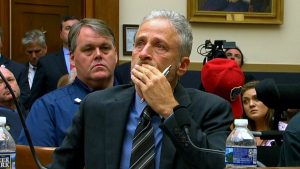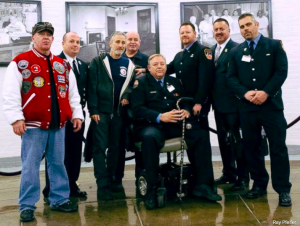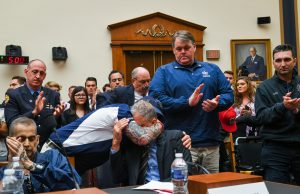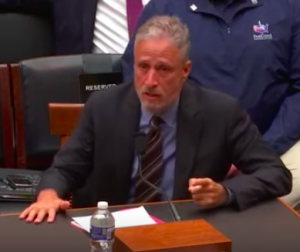
Have you seen the video or listened to the audio recording of Jon Stewart’s testimony to Congress (the House Judiciary Committee in this case) on June 11, 2019? It was a riveting presentation and one that we can all learn from.
Jon was speaking in support of the reauthorization of the 9/11 Victim Compensation Fund. The passage of the bill would permanently reauthorize the fund that compensates victims of 9/11 and their families. After many years of hemming, hawing and delays, Congress must make a decision whether or not to continue the 9/11 Victim Compensation Fund. The measure was originally created after September 11, 2001 to help pay for medical and economic losses as a result of the terrorist attacks. The passage of the bill would permanently reauthorize the fund that compensates victims of 9/11 and their families, including first responders like firemen and policemen who came to the aid of those who were gravely impacted on that horrible, fateful day.
(You can find Jon’s full testimony as captured by PBS News Hour on YouTube: https://www.youtube.com/watch?v=HT5FTrIZN-E)
Who is Jon Stewart?
Jon Stewart is an American comedian and TV personality. He was the former host of the”Daily Show,” a satirical news program. Jon could be seen on Comedy Central from 1999 to 2015. You can now watch the Daily Show weeknights with the current host, Noah Trevor. It’s one of my personal favorites!
 If you didn’t know of Jon Stewart before, you would never have thought he was a comedian by profession. There was absolutely nothing funny about his presentation before the House Judiciary Committee. But what you will see is a powerful, authentic, compelling presentation performance by a master communicator. There were so many incredible high-engagement presentation techniques that he employed in his speech. As an executive presentation coach, I am motivated to share them with you so you can up your skill set when giving your next presentation.
If you didn’t know of Jon Stewart before, you would never have thought he was a comedian by profession. There was absolutely nothing funny about his presentation before the House Judiciary Committee. But what you will see is a powerful, authentic, compelling presentation performance by a master communicator. There were so many incredible high-engagement presentation techniques that he employed in his speech. As an executive presentation coach, I am motivated to share them with you so you can up your skill set when giving your next presentation.
No doubt your topic will be very different from the topic that Jon spoke about before Congress. The stakes for your presentation are unlikely to be as important as Jon’s. The issues that you address may not be as serious or life-threatening than the ones Jon addressed. And your audience is unlikely to be as hostile or non-responsive as the crowd that Jon and his group of champions have been facing these many years. However, there is something we can learn from Jon and his presentation.
What We Can Learn about Public Speaking From Jon Stewart’s Presentation
Here’s what I loved about Jon’s recent testimony. In addition to learning some really, really important information that needs to be acted upon, I observed a masterful public speaker putting his skills to good use. I also spotted some outstanding presentation techniques. Not in any particular order (other than the things I noticed first), here is what I noticed:
- Passion Moves People. Jon clearly has a commanding presence. His passion for the topic is undeniable. He knows his topic. He believes in his cause. His emotion is genuine and heartfelt. It’s contagious. We want to care about what he cares about.
 Personal Stories Are Powerful. It was as if Jon brought the New York Fire Department legend Ray Pfeifer back to life when he told a personal story about Ray. Photo to the right (courtesy of ABC) shows Ray Pfeifer sitting in his wheelchair along with other champions of this cause. Ray stayed at the World Trade Center site for months after the 9/11 attacks to help with the clean up. In Jon’s personal story he used narrative very effectively. Even though we, the listeners, were not there at the moment when Ray imparted his wisdom on Jon, we could see it and feel it. We were transported back in time to when Jon and Ray had that conversation. This personal story not only created a powerful experience for the listener, it helped to make Jon’s point.
Personal Stories Are Powerful. It was as if Jon brought the New York Fire Department legend Ray Pfeifer back to life when he told a personal story about Ray. Photo to the right (courtesy of ABC) shows Ray Pfeifer sitting in his wheelchair along with other champions of this cause. Ray stayed at the World Trade Center site for months after the 9/11 attacks to help with the clean up. In Jon’s personal story he used narrative very effectively. Even though we, the listeners, were not there at the moment when Ray imparted his wisdom on Jon, we could see it and feel it. We were transported back in time to when Jon and Ray had that conversation. This personal story not only created a powerful experience for the listener, it helped to make Jon’s point.- Take Your Time. Jon did not speed through this presentation. He took his time. He even allowed himself a minute to compose himself when he started to get emotional. He remained confident during this pause and we waited for him. Jon knows that one should never be rushed in one’s communication. Pausing, and the absence of sound, draws people in.
- Composure is Important. Jon also knew that tears were not going to motivate Congress. They would likely take that as a weakness. So Jon made sure that he could maintain his composure while still giving a personal and emotional speech. He had practiced and prepared for this, knowing that he might get emotional. He knew how to reset himself and bring himself back to composure.
 Use of Metaphor. Jon was so creative in his testimony. He used several metaphors including the room itself, time, business cards, prayer cards, and ‘your job.’ We all understood that each of these had far greater, deeper meaning than simply the words.
Use of Metaphor. Jon was so creative in his testimony. He used several metaphors including the room itself, time, business cards, prayer cards, and ‘your job.’ We all understood that each of these had far greater, deeper meaning than simply the words.- No PowerPoint slides. Jon didn’t need to show us any slides, photos, or graphs to get our attention or to make his point. He used a few numbers like “5 seconds” and “18 years.” Those numerical references were very effective, so much so that he repeated them several times.
- A Bold Ask. There was no uncertainty about what Jon wanted Congress to do. Jon was singularly focused on his objective – to get the bill reauthorized.
- Know What Emotions You Want Your Audience to Feel. Jon effectively engaged many of our senses in his presentation. He spoke to our hearts, not just our heads, in his presentation. His testimony got us to feel pride and shame, hope and despair, courage and weakness, and much more. What emotions do your presentations conger up? How do you want your audience to feel?
 Powerful closing statement. Jon’s final words were so powerful they are worthy of repeating. He said, “They responded in five seconds. They did their jobs. Courage, grace, tenacity, humility. Eighteen years later, DO YOURS. (pause) Thank you.”
Powerful closing statement. Jon’s final words were so powerful they are worthy of repeating. He said, “They responded in five seconds. They did their jobs. Courage, grace, tenacity, humility. Eighteen years later, DO YOURS. (pause) Thank you.”- Don’t Go Alone. Jon was not deterred by empty seats. He used the absence of Congressional members to help make his point. He also brought his own crowd to help balance the power. He didn’t go in alone. He didn’t speak alone. He was speaking on behalf of many. He had his own show of force.
- Give It Your All, Despite Your Audience. Ultimately, Jon knows his core audience is Mitch McConnell, the Senate Majority Leader. McConnell was not physically present when Jon Stewart gave his moving testimony. McConnell’s chair was empty. Seven days later, McConnell was quoted on CNN as saying that he vowed to fully fund The 9/11 Victim Compensation Fund, but wonders why Jon Stewart is “all bent out of shape.” At some time or other, most presenters will have to deal with difficult people in the audience, or someone who will have a say in your presentation outcome. But we must not lose heart or hold back. Sometimes you have to give it everything you have, even if that means getting bent out of shape! You rock, Jon Stewart!

